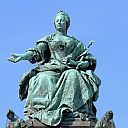0263 "denn gerade Wien ist der Ort, wo die Schule der monumentalen Plastik den geeigneten Boden hat"
Die Wiener Bildhauerschule des Caspar Zumbusch als Ausbildungszentrum für Künstler in der Habsburgermonarchie des ausgehenden 19. Jahrhunderts
Identifiers (Article)
Abstract
This paper focuses on Caspar von Zumbusch, who was one of the leading sculptors of the second half of the 19th century in Vienna. At the initiative of the art historian Rudolf Eitelberger, the German sculptor was appointed to the Academy of Fine Arts (Akademie der bildenden Künste) in Vienna in 1873 and became the founder of the so-called Vienna school of monumental sculpture. By means of a statistical analysis of the matriculation books that serve as reliable documentation of the students enrolled in the Academy, the number and origin of Zumbusch’s students can be determined for the first time. The results show that Zumbusch taught numerous students from all over the Austro-Hungarian Empire, which made the Vienna Academy the preeminent centre for sculptors in the Dual Monarchy. Once the students had graduated, Zumbusch recommended them for projects and thereby established a large network of sculptors across the Austro-Hungarian Empire towards the end of the 19th century.
Statistics


License

This work is licensed under a Creative Commons Attribution-NonCommercial-NoDerivatives 4.0 International License.



